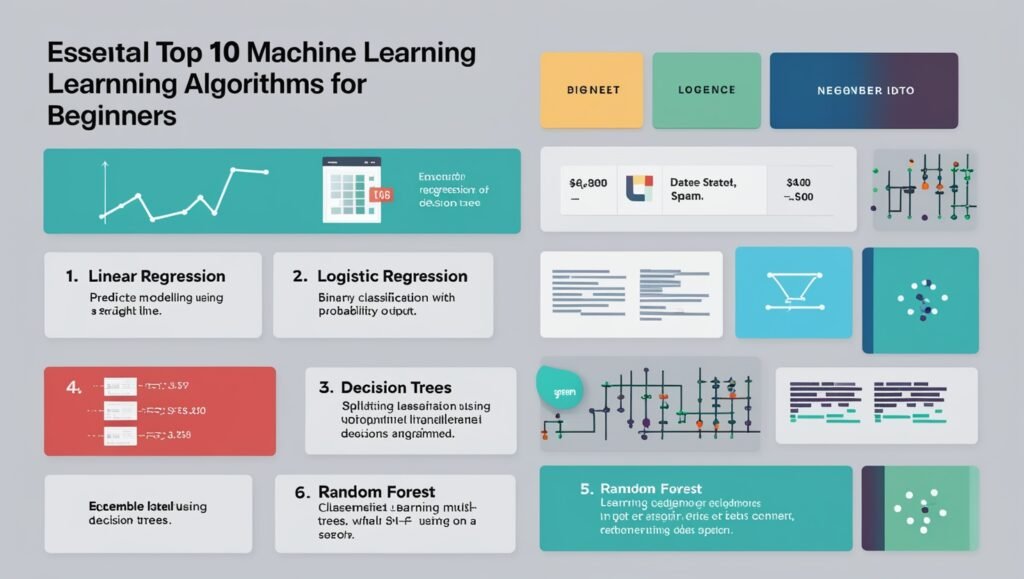Machine learning is one of the most transformative technologies of our time, capable of driving astonishing innovations across various industries. As a beginner data scientist, understanding the foundational algorithms is crucial to building your skills and tackling real-world problems. In this article, we will explore the top 10 machine learning algorithms that serve as building blocks for any aspiring data scientist.

1. Linear Regression
Linear regression is one of the simplest and most widely used algorithms in machine learning. It is primarily used for predictive modeling and estimates the relationship between a dependent variable and one or more independent variables.
How It Works
Linear regression employs a linear equation (y = mx + b) to model the relationship. The aim is to find the best-fitting straight line through the data points, minimizing the difference (error) between the predicted values and actual values.
Use Cases
- Predicting housing prices based on features like size, location, and age.
- Estimating sales based on marketing spend.
Benefits
- Easy to interpret and implement.
- Requires minimal computational resources.
2. Logistic Regression
Despite its name, logistic regression is used for binary classification problems rather than regression tasks. It predicts the probability of an outcome based on a logistic function.
How It Works
Logistic regression utilizes the logistic function to constrain the output between 0 and 1. Based on the probability, a threshold (usually 0.5) is used to classify outcomes.
Use Cases
- Spam detection in emails.
- Disease occurrence prediction.
Benefits
- Provides probabilistic interpretations.
- Handles binary classifications effectively.
3. Decision Trees
Decision trees are versatile machine learning algorithms that can be used for both classification and regression tasks by modeling decision paths based on feature values.
How It Works
A decision tree splits data into subsets based on feature values. Each internal node represents a feature, each branch represents a decision rule, and each leaf node represents an outcome.
Use Cases
- Customer segmentation.
- Credit scoring.
Benefits
- Intuitive and easy to visualize.
- No need for extensive data preprocessing.
4. Random Forest
Random forest is an ensemble method that improves the accuracy of decision trees by training multiple trees on different subsets of data and averaging their predictions.
How It Works
Random forest builds multiple decision trees using bootstrapping (sampling with replacement) and combines their outputs to enhance performance and reduce overfitting.
Use Cases
- Stock price forecasting.
- Fraud detection.
Benefits
- High accuracy and robustness.
- Handles large datasets effectively.
5. K-Nearest Neighbors (K-NN)
K-NN is a simple and intuitive algorithm used for both classification and regression, based on the notion that similar data points exist close to each other in the feature space.
How It Works
K-NN calculates the distance (typically Euclidean) between a point and all other points in the dataset. It classifies a point based on the majority label of its ‘k’ nearest neighbors.
Use Cases
- Recommender systems.
- Image recognition.
Benefits
- Simple to implement and understand.
- No assumptions about data distribution.
6. Support Vector Machines (SVM)
SVM is a powerful algorithm used primarily for classification tasks. It works by finding the hyperplane that best separates different classes in the feature space.
How It Works
SVM tries to maximize the margin between different classes, ensuring the largest possible distance between the nearest points of the classes (support vectors) and the hyperplane.
Use Cases
- Image classification.
- Text categorization.
Benefits
- Effective in high-dimensional spaces.
- Well-suited for complex but small- to medium-sized datasets.
7. Naive Bayes
Naive Bayes is a family of probabilistic algorithms based on Bayes’ theorem, assuming independence among predictors. It’s particularly popular for text classification tasks.
How It Works
Naive Bayes calculates the probabilities of different classes based on feature values and uses Bayes’ theorem to update these probabilities based on new evidence.
Use Cases
- Sentiment analysis.
- Document classification.
Benefits
- Highly efficient and fast, even with large datasets.
- Effective for text-based data.
8. Gradient Boosting Machines (GBM)
Gradient boosting is an ensemble technique that builds models sequentially, where each new model corrects errors made by the previous ones.
How It Works
GBM uses weak learners (usually decision trees) to refine predictions. Each tree is added to minimize the loss function, adapting to the errors of previous trees.
Use Cases
- Customer churn prediction.
- Credit risk modeling.
Benefits
- High predictive accuracy.
- Effective for various types of problems.
9. Neural Networks
Neural networks are inspired by human brain function, consisting of interconnected nodes (neurons). They are particularly powerful for complex tasks involving unstructured data.
How It Works
Neural networks consist of layers (input, hidden, and output). Data is processed through revolutionary transformations, allowing the model to learn intricate patterns.
Use Cases
- Image and speech recognition.
- Natural language processing.
Benefits
- Capable of capturing non-linear relationships in data.
- Suitable for high-dimensional datasets.
10. k-Means Clustering
k-Means is an unsupervised learning algorithm used for clustering tasks, which organizes data points into groups based on feature similarities.
How It Works
k-Means randomly selects ‘k’ centroids, then iteratively assigns data points to the nearest centroid until minimal variance is achieved within clusters.
Use Cases
- Market segmentation.
- Image compression.
Benefits
- Simple and easy to implement.
- Scales well with large datasets.

Conclusion
Mastering these ten algorithms is fundamental for any beginner data scientist keen on building a solid foundation in machine learning. Each algorithm serves unique purposes and offers different advantages, making them suitable for various applications. As you progress, diving deeper into each method will reveal their intricacies, allowing you to refine your approach to real-world data problems.
If you’re ready to start your journey into machine learning, consider exploring additional resources, such as online courses and coding tutorials. Websites like Kaggle offer datasets and competitions that allow you to practice these algorithms in real-world scenarios.
Additional Resources:
- Books: Hands-On Machine Learning with Scikit-Learn, Keras, and TensorFlow by Aurélien Géron
- Courses: Coursera’s Machine Learning course by Andrew Ng
- Communities: Join communities like Towards Data Science for articles and guidance.
By equipping yourself with knowledge of these algorithms, you will not only enhance your data science skills but also prepare yourself for a career filled with innovative opportunities. Start experimenting, keep learning, and don’t hesitate to share your findings with the community!




I don’t think the title of your article matches the content lol. Just kidding, mainly because I had some doubts after reading the article.